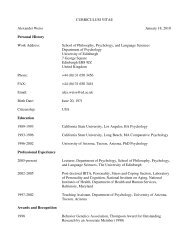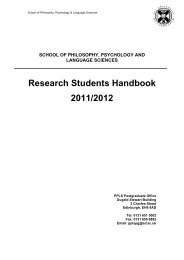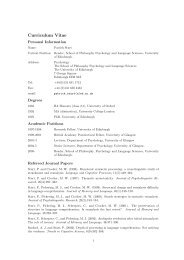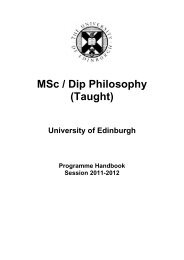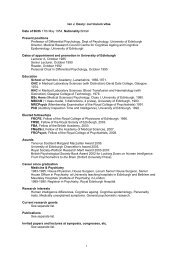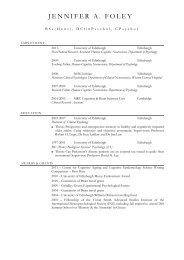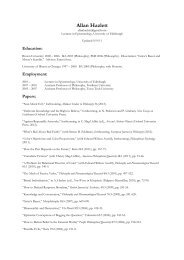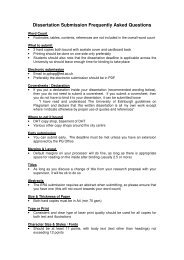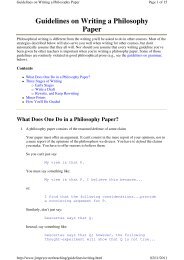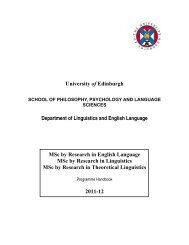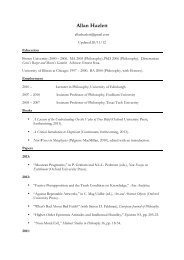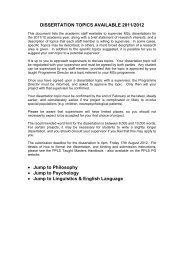University Feedback Standards and Guiding Principles
University Feedback Standards and Guiding Principles
University Feedback Standards and Guiding Principles
You also want an ePaper? Increase the reach of your titles
YUMPU automatically turns print PDFs into web optimized ePapers that Google loves.
commenting on a sample assignment; 'dropin' advice; a supervision meeting; a<br />
debriefing by a professional practitioner; wholeclass feedback on how an exam<br />
question had been tackled<br />
c. <strong>Feedback</strong> needs to be fit for purpose. The particular kinds of feedback that are offered within<br />
any given course or programme unit will vary, depending on what <strong>and</strong> how students are<br />
expected to learn <strong>and</strong> the resources available.<br />
d. Good feedback <strong>and</strong> highquality learning go h<strong>and</strong>inglove. Where feedback is effective, it<br />
can help students to improve what they know, underst<strong>and</strong> <strong>and</strong> are able to do — <strong>and</strong> so attain<br />
their full potential.<br />
e. In order to be effective, feedback needs to be prompt, informative <strong>and</strong> helpful.<br />
· prompt feedback is returned to students within the agreed timescale for the work<br />
submitted;<br />
· informative feedback highlights strengths <strong>and</strong> weaknesses, giving specific examples<br />
or explanations;<br />
· helpful feedback offers suggestions about how to improve.<br />
f. Students’ engagement with feedback thrives when they experience it in a wide range of<br />
forms <strong>and</strong> settings, while gaining practice in acting upon <strong>and</strong> giving feedback as well as<br />
receiving it.<br />
g. Staff expertise in feedback grows when new tutors, demonstrators, supervisors <strong>and</strong> lecturers<br />
are wellsupported in learning how to give feedback effectively in their subject area, <strong>and</strong><br />
when good practice <strong>and</strong> innovation in feedback are shared amongst staff at all levels of<br />
experience. [A website resource has been compiled on Improving <strong>Feedback</strong>, which links a<br />
range of innovative feedback strategies to over 200 caseexamples drawn from across the<br />
subject range <strong>and</strong> from within <strong>and</strong> outwith Edinburgh: www.tla.ed.ac.uk/feedback.htm]<br />
h. <strong>Feedback</strong> can only work well when it is a joint <strong>and</strong> shared responsibility.<br />
The onus is on students to:<br />
• familiarise themselves with when,<br />
where <strong>and</strong> how feedback is provided<br />
• develop their underst<strong>and</strong>ing of<br />
assessment expectations, criteria<br />
<strong>and</strong> st<strong>and</strong>ards in their chosen degree<br />
programme<br />
• collect <strong>and</strong> reflect on the feedback<br />
provided, <strong>and</strong> grasp opportunities to<br />
put it to good use<br />
The onus is on teachers to:<br />
• design courses <strong>and</strong> programmes in<br />
ways that enable students to get <strong>and</strong><br />
to act on feedback<br />
• inform students when, where <strong>and</strong><br />
how feedback will be provided<br />
• provide feedback which is prompt,<br />
informative <strong>and</strong> helpful, within the<br />
resources available to them<br />
i. The quality of feedback is safeguarded when it is monitored <strong>and</strong> when it is valued<br />
appropriately in staff appraisal <strong>and</strong> promotion.<br />
Approved by Senatus on 16 June 2010<br />
2



